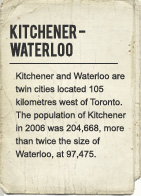Population
Though a few Jewish families began to settle in the Kitchener area in the 1890s, it wasn’t until after the turn of the century that the community solidified. By 1911, there were at least 14 Jewish families, approximately 75 individuals. In the 1920s, a second wave of European immigrants swelled the Jewish population from 298 in 1921 to 411 ten years later.
By 1931, Kitchener had surpassed Kingston’s Jewish population and led the small communities of Ontario. After this, growth slowed because of the government’s drastic restriction of immigration during the years of the Depression and the Second World War. The city’s Jewish population actually fell slightly in the 1940s, from 425 in 1941 to 391 in 1951. There was no significant population increase until the 1950s, when the community was augmented by the dozen or so Holocaust survivors who chose to make the growing city their new home. In the early 1960s, Canadian Jewish Congress reports stated the population was around 500 persons, or about 200 families.
In Waterloo, the Jewish population has always been smaller than Kitchener’s, until recent years. This can be explained by the fact that Waterloo itself is a smaller city, even to this day. In the early twentieth century, it had a less diversified economy that did not offer the same opportunities to immigrants that Kitchener did. In 1891, there was only one Jewish family living in Waterloo: the Goldbergs. By 1901, the Goldbergs had left and two other families, the Bergs and Cohens, had come. After this, no Jews were listed in the Waterloo Census until 1931, when there were still only four. The population grew to 43 in 1951, but the community did not really begin to expand until the 1960s. This coincided with a general population expansion in Waterloo, when the newly-established University of Waterloo brought many academics and staff with their families to the city, and Waterloo’s industry and business sectors experienced a boom.







